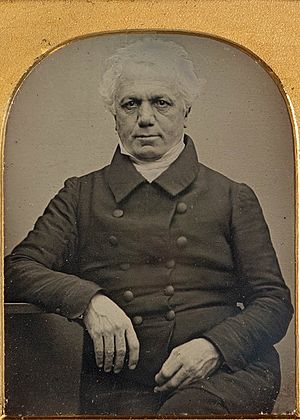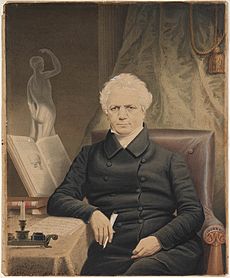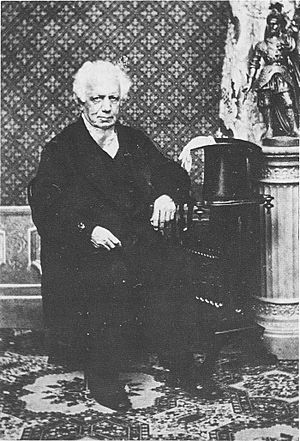William Bland facts for kids
Quick facts for kids
William Bland
|
|
|---|---|

Dr William Bland c. 1845, by George Barron Goodman
|
|
| Born | 5 November 1789 London, England
|
| Died | 21 July 1868 (aged 78) Sydney, Australia
|
| Spouse(s) |
Sarah Henry
(m. 1817; died 1840)Eliza Smeathman
(m. 1846) |
| Parent(s) |
|
| Relatives | John Benjamin Heath (brother-in-law) |
William Bland (born 5 November 1789 – died 21 July 1868) was an important public figure in the early Australian colony of New South Wales. He was a surgeon who arrived in Australia as a convict. However, he became very influential in early Australian healthcare, education, and science.
Bland was born in London, England. He became a surgeon in the Royal Navy. In 1813, he was involved in a serious incident in Bombay (now Mumbai). Because of this, he was sent to Australia as a convict. He first went to Van Diemen's Land (now Tasmania) and then to New South Wales. He worked at the Castle Hill Lunatic Asylum. He received a full pardon in 1815. This was partly because there were not many qualified doctors in the colony.
As one of the few surgeons, Bland practiced medicine in Sydney for over 50 years. He created new surgical methods and tools. He published his ideas in medical journals like The Lancet. In 1859, he helped start the Australian Medical Association. He also worked with the Benevolent Society, which helped people in need.
Outside of medicine, Bland helped found the Sydney Mechanics' School of Arts. This school taught practical skills and knowledge. He also served as treasurer and president of Sydney College. This college was an early version of the University of Sydney. Bland was also an inventor. He patented a device to stop fires. He even designed an experimental steam-powered airship.
Bland became involved in politics soon after arriving in New South Wales. In 1818, he was sent to prison for a year for writing critical things about Governor Lachlan Macquarie. He joined other emancipists (former convicts who gained their freedom). He supported William Wentworth's ideas for a government elected by the people. He also wanted more rights for ex-convicts. In 1835, he helped create the Australian Patriotic Association. This group worked for political changes.
After new laws were passed, Bland was elected to the New South Wales Legislative Council in 1843. This was one of the first times people in the colony could elect their representatives. He served several terms in parliament. He supported land reform and opposed the power of large landowners.
When William Bland died in 1868, he was given a state funeral. This showed how important he was to the colony. Places like Bland Shire and the former Division of Bland are named after him.
Contents
William Bland was born in London on 5 November 1789. His father, Robert Bland, was a doctor who specialized in childbirth. William likely went to a good school, possibly the Merchant Taylors' School, Northwood. He followed his father into medicine.
In January 1809, he passed an exam to become a "surgeon's mate" in the Royal Navy. He was promoted to naval surgeon in 1812. He served on a ship called HMS Hesper in the East Indies Station.
Life in Australia
Bland arrived in Hobart, Tasmania, as a convict in January 1814. He traveled with another person who was also a convict. Even though they were convicts, they were treated well by officials. Lieutenant-Governor Thomas Davey even invited them to Government House. This surprised Governor Lachlan Macquarie, who thought it was unusual.
In June 1814, Bland was sent to Sydney. Governor Macquarie quickly granted him freedom. In September 1814, Bland became the medical superintendent at the Castle Hill Lunatic Asylum. He also received some government land. It was common for convicts to get important jobs back then. This was because there weren't enough qualified people. Other doctors like D'Arcy Wentworth and William Redfern were also former convicts. Bland received a full pardon on 27 January 1815.
In 1818, Bland wrote anonymous critical writings about Governor Macquarie. He made fun of the Governor's desire to have his name on buildings. Bland's handwriting was recognized. He was found guilty of libel and sentenced to 12 months in prison. He served his time in Parramatta.
Helping the Community
In 1825, Bland helped start the Sydney Public Free Grammar School. The first stone for a new building was laid in 1830. The Sydney College opened on 19 January 1835. Bland was the treasurer from 1835 to 1844. In 1845, he became its president. He held this position when the buildings were sold to the University of Sydney in 1853.
Political Involvement
In 1830, Bland spoke out against plans to sell large areas of government land. In 1831, he joined a group called the Australian Landowners Association. This group fought against new land rules.
In 1834, a Member of Parliament in England, Sir Edward Lytton Bulwer, suggested that Australians should form an organized group. He thought this group should have someone in England to represent them. Because of this, the Australian Patriotic Association was formed in 1835 by William Wentworth. Bland was the secretary of this group.
Bland helped write letters for the Australian Patriotic Association between 1839 and 1841. These letters showed the struggles for self-government in Australia. As secretary, Bland helped create two proposals for a "representative constitution." This new constitution was approved in 1842. Bland represented Sydney when it was read and approved.
Bland was elected to the New South Wales Legislative Council twice. He represented the City of Sydney from 1843 to 1848 and again from 1849 to 1850. After the colony gained more self-government, he was appointed to the NSW Legislative Council from 1858 to 1861.
In 1849, William Wentworth tried to pass a law to create the University of Sydney. He wanted Bland to be one of its first leaders. However, another politician, Robert Lowe, brought up Bland's past. The law failed at that time. When the law was brought up again, Bland's name was not included. The University of Sydney was then created without him as a leader.
In July 1856, a celebration was held for Australia getting a new Constitution from the British government. Bland was asked to lead the event and received a warm welcome. On 5 November 1858, he was given money and a special candelabrum for his service to the community. He retired from the Legislative Council on 21 March 1861.
Other Activities and Later Life
In 1843, Bland claimed that someone else had taken credit for his invention. This invention was a way to prevent spontaneous combustion. He said he invented it in 1839.
Around 1845, Bland was the subject of the oldest surviving photograph taken in Australia. This photo is kept at the Mitchell Library in the State Library of New South Wales.
Bland continued to work as a doctor until 1868. In 1863-64, he exchanged letters with Father Therry. They discussed the best way to build a telegraph cable across the Atlantic Ocean.
He died in Sydney on 21 July 1868 from pneumonia. He was given a State Funeral, which is a special public ceremony.
Personal Life
In April 1817, Bland married Sarah Henry. She was 20 years old. Her father, William Henry, was a missionary. Sarah had lived in Tahiti before coming to Sydney. Their wedding was held at St Philip's Church.
Bland and his wife separated. Bland lived in a two-story house in Pitt Street, Sydney. He had several convict servants and sometimes took in boarders. He had many pets, including a spaniel dog, a one-eyed magpie, a cockatoo, and several snakes. In February 1846, Bland married Eliza Smeathman. She was the widow of his close friend, Charles Smeathman.
Legacy

Bland County, New South Wales was named in his honor.
An area for elections in the first federal parliament, the Division of Bland, was named after him. This area was later removed in 1906.
Bland is also remembered in the name of Bland Shire Council. Bland Street in the Sydney suburbs of Ashfield and Haberfield is also named after him. He bought land there in 1839. Bland Street and the Bland Oak in Oakdene Park, Carramar, New South Wales are located on land he acquired in 1840.
To honor Dr. William Bland's contributions to medicine in early Australia, a twelve-story building was built in 1960. It is located opposite Sydney Hospital at 229–231 Macquarie Street, Sydney. It is called the William Bland Centre. It mainly houses private medical practices.
A public housing building, Blandville Court, on Victoria Road at Gladesville is named after him. This is because the nearby suburb of Henley was originally called Blandville after Bland.
See also
- List of convicts transported to Australia
- Photography in Australia


